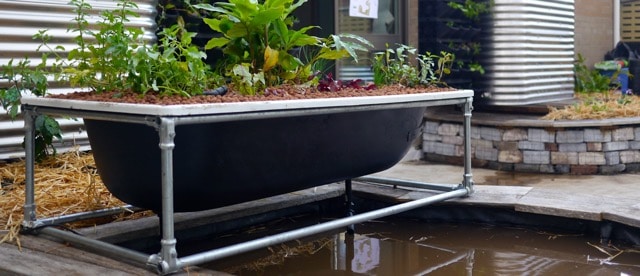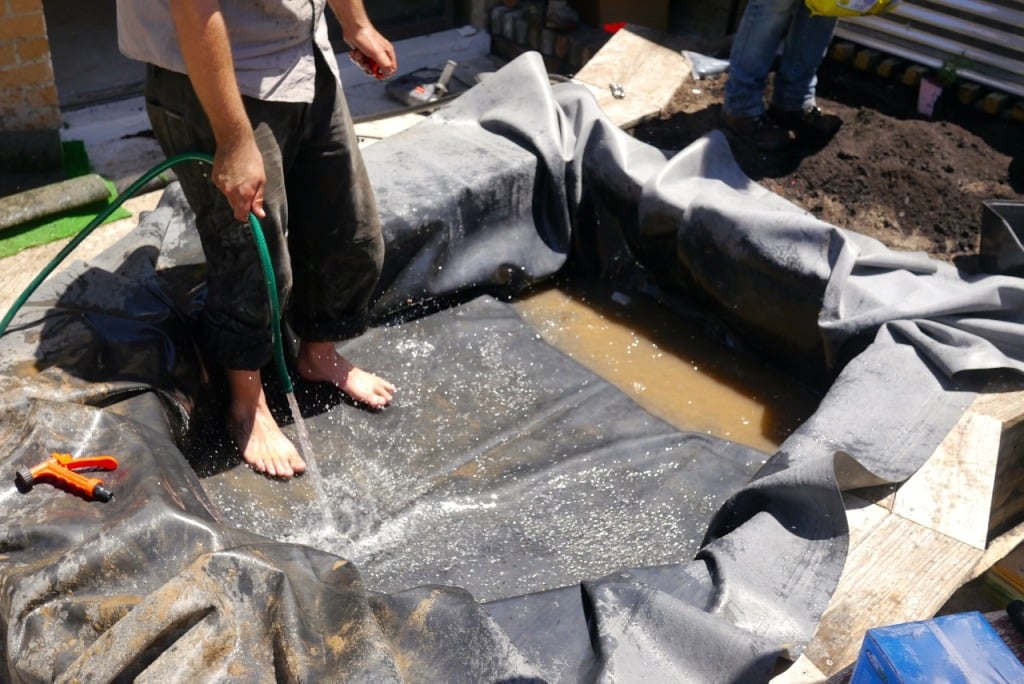
Think making your own aquaponics setup would be too hard and costly? Think again my friends. Here’s a straightforward and easy way to grow some waterwise greens in your home system.
We made this super easy and downright cheap aquaponics system for the 107 Rooftop Garden in Redfern, Sydney, because we wanted to show folks how straight forward a home aquaponics setup can be.
What is aquaponics?
Aquaponics is a food growing system that utilizes a synergy between fish and plants to create an extremely water-wise growing system.
At it’s most basic, an aquaponics system is a growbed (where the food plants grow) and some sort of fish in a pond or tank.
The nutrient-rich water from the fishpond is pumped into the growbed, where the nutrients are taken up by the plant roots.
The now clean and oxygenated water (thanks, plant roots) then drains back into the fish pond, creating happy fish. And around the cycle goes.
On a large scale, the fish (or yabbies) in your aquaponics system can be used for eating.
Or, on a small scale like this, goldfish or other hardy freshwater aquarium fish can be used instead, purely for the nutrient they provide the plants. And they’re nice to look at.
You can read a brief history of aquaponics here. But back to our pipe-and-bathtub macgyvering.
The basics of this DIY bathtub aquaponics setup
There’s not actually a whole lot to this setup – it’s very simple, and it works really well to produce healthy herbs all through crazy summer heat.
In this context we used a pond for the fish , but you could use another bathtub for the fish tank just as easily. Go with whatever suits your situation, budget + needs.
The bits:
- 1 metal bathtub
- 1 small aquarium pump
- 1 bell siphon (description and how to here)
- some sort of pond (could be another bathtub)
- pebbles or clay beads for growing medium
- pipes cut to size of bathtub dimensions
- fence fittings like these to clip the pipe frame together
Once all the bits were acquired, this aquaponics setup was constructed on the morning of our first planting day at the 107 rooftop garden, by Floyd Constable; fab teacher, bush mechanic and aquaponics nut.
The Frame
The pond
This pond was incorporated into the garden gabions we built, with a wooden backing. It’s quite shallow ad goes in under the growbed to give the fish a place to hide from the sun and over-enthused visitors.
The pond used basic pond-liner plastic, with a layer of dumpster astroturf underneath to protect the membrane from holes.
The Grow bed
There’s really nothing like a good bath. Especially for this purpose. Bathtubs make great home aquaponics growbeds – they’re water tight, strong, and have a nice big hole at one end to let the water out. Perfect.
The Plants
The possibilities for planting out a grow bed are fairly endless – people grow everything from herbs to tomatoes to beetroot in them.
For this context, we used whatever plants we had at hand to get the system up and running – ginger, sorrel, beetroots, chives and vietnamese mint (don’t plant mint, by the way – we pulled that out pretty quickly).
Long term, we’ll be planting this with hardy herbs that flourish in good water, and maybe some seasonal veg.
Next steps
Once this bed was planted out, we put some liquid seaweed in the pond water as stand-in nutrient for the plants and left the system to ‘cycle’ for a few weeks before adding the fish.
By the end of the first cycling, the water will be filtered by the plant roots many times and will be clear. It will also have a pH that’s great for the fish that will be put in here – just ornamentals like goldfish or murray river rainbow fish for this setup.
We’ll also add azolla, a small water fern, into the pond. It’s a great fish food and will help keep things balanced. If the azolla goes crazy, it’s a great compost additive, so all good there.
The power load for the small aquarium pump will be maybe $50 over 12 months. The same as a small fish tank. It’s nothing, but given we’ll add very little water to the system over this time, the energy audit is pretty darn good.
Ongoing inputs
- power for small aquarium pump (maybe $50 worth per 12 months)
- occasional fish food
- a small amount of water to top up the pond
Not a bad energy input audit! And as a result, we can expect a modest but consistent harvest of greens all year round.
Notes
Where to get the pipe: from any metal supplier – measure up your bathtub and call them to cut the pipe to your lengths required. Once youv’e done this a few times it’s like ordering a pizza. Not at all specialist or anything. Do it.
Where to get the fittings: your metal supplier should have these, here’s a reference for the fence fittings.
Where to get the bathtub: go to your nearest tip shop! If you’re in Sydney, the fabulous Kimbriki has never failed to deliver. Failing that, try junkyards.
Where to get the pond liner: any landscaping supplies or big hardware store.
Where to get the growbed clay pebbles: You can buy them from Canna or hydro or aquaponics suppliers. OR you can use river pebbles, if you wash them really well first.
Big thanks to Floyd Constable for his ongoing aquaponical enthusiasm, and for putting this unit together. And also thanks to Steve of Alice Springs, at whose place we first saw this great idea.



































fantastic.
Awesome! I have a question about aquaponics and frogs. We have two projects in the pipeline -an aquaponics system and frog pond habitat- could the two be brought together?
Yes absolutely you could, though you would still need fish in the mix as well.
Thanks Kirsten! I’ll let you know how we go 🙂
there is a real likelihood that goldfish will eat frog spawn and tadpoles. If you want the two together you might need to do some research on the best fish.
Hi, this could be a stupid question, but….. would the food taste fishy?? I know it sounds silly, but I can tell when food has been grown using fish fertiliser (aka charlie carp product) and it just isn’t right!!
Nan 🙂
please give me info about that beautiful cistern behind the fish pond!
that would be a slimline stainless steel tank from the amazing crew at http://www.selectwatertanks.com.au/
One of my students has a similar set-up: bath-tub on top, old inflatable pool on the bottom. The pool is not much bigger than yours, but a little bit deeper. He grows jade perch feed on roaches and azolla (grown in another pond and frozen in ice-cube trays). The harvest is amazing. You just have to be careful not to puncture the pool when fishing!
The use of metal piping is a great idea: a bath-tub full of water is really heavy.
how does he grow / catch the roaches? very interested to hear 🙂
Hey Kirsten,
Do you ever have open days at 107? Have got some locals who would be keen to see the set up but couldn’t afford the course, so I’d like to show them a working system and I can explain the design elements to them later. It’d be helpful for them to see a working system.
Cheers
Jess
yep there’s one coming up on 21 march i belive, and we’ll be doing community days before then, everyone welcome
Great stuff!
Thanks for this article. It really makes aquaponics accessible. May I bother you for a couple of details? Roughly, have you determined your turn-over times in an hour or day (how many times the full volume is circulated)? What is the pH? I’ll pass along the link. Kindest regards!
Thanks for the article which was very informative. I have a question about the working of motor to pump water from pond to grow bed. Is this a continuous process, whether the motor is turned on 24 hrs. Os is there a certain interval we have to turn it on to circulate the water? Thanks.
the pump is on constantly – it’s a small aquarium pump so draws about as much power as a light globe
Nice job, but the pics leave me with questions (as I do not care for fish, this may be obvious to those that do) what is in the tub, I’m assuming some sort of filter system. Is the large round pipe with holes the pump? Is the filter attached at the tub drain something standard or specialized?
Thanks.
Agree, could you diagram the piping?
we probably won’t at this stage sorry! Will have to go off the pics –
If you want some help woth this, contact Lighthouse Hydroponics in Noosaville – They are really good at helping make a great and affordable system
Great idea! We are setting up a quaquaponics system… aquaponics with ducks instead of fish and we may just try using bathtubs with frames as our grow beds. Thanks!
River pebbles are a bit of a no-no. The removal of pebbles from rivers in impoverished countries, or anywhere, causes environmental damage.